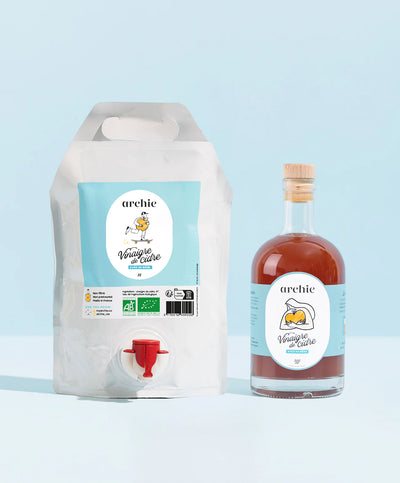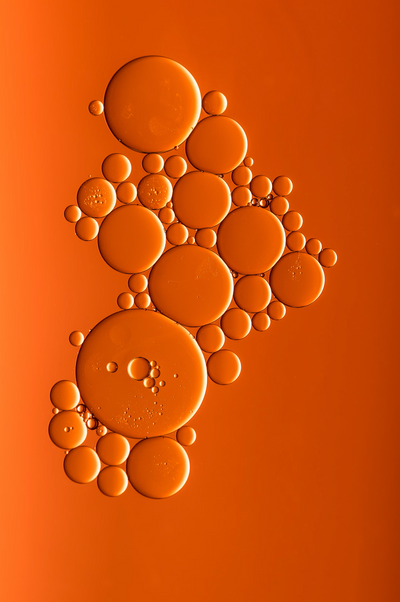Since the publication of Glucose Revolution by Jessie Inchauspé (aka @glucosegoddess), acetic acid has gained visibility. This natural compound found in apple cider vinegar is now recognized for its beneficial effects on digestion, blood sugar, satiety, and much more.
We had the pleasure of collaborating with Jessie Inchauspé for a year; this partnership has now come to an end.
What is acetic acid?
Acetic acid (CH₃COOH), also known as ethanoic acid, is a weak organic acid belonging to the carboxylic acid family. It is the main active component of vinegar , responsible for its tangy taste and properties.
Key points
-
Natural sources : present in vinegar, resulting from the fermentation of alcohol.
-
Production : either by acetic fermentation (via bacteria such as Acetobacter ), or by chemical synthesis .
-
Uses : food industry (vinegar, preservative), chemical industry (plastics, textiles, medicines).
-
Properties : Soluble in water, slightly corrosive in high concentrations, but perfectly safe when diluted.
How is it produced?
By acetic fermentation (traditional method)
Acetic acid bacteria convert ethanol into acetic acid in the presence of oxygen.
Equation :
C₂H₅OH + O₂ → CH₃COOH + H₂O
It is this natural process that gives rise to raw, unpasteurized cider vinegar , rich in living microorganisms.
By chemical synthesis (industrial method)
Ethanol is oxidized to acetic acid using catalysts. This method is used for large-scale production, particularly in industry.
The benefits of acetic acid according to Jessie Inchauspé
Improve digestion
Acetic acid corrects excess or deficiency of gastric acidity , relieves heartburn and bloating. It also stimulates enzymatic activity and promotes good digestive balance.
Support intestinal transit
Thanks to its richness in prebiotics , it nourishes the good bacteria in the intestine, promotes regular bowel movements, limits fermentation and helps eliminate toxins.
Promote satiety and weight loss
Taken before a meal, acetic acid reduces appetite , limits cravings, and improves feelings of fullness. It also affects fat storage and can help reduce BMI, body fat, and triglycerides.
Regulate blood sugar
This is one of the most well-known and documented effects. A tablespoon of apple cider vinegar in a glass of water before a meal can reduce glycemic impact by 30% .
Mechanisms of action
-
Slows gastric emptying
-
Inhibits the enzyme alpha-amylase , which breaks down starch into glucose
-
Improves insulin sensitivity
-
Promotes glucose uptake by muscles
The result: fewer blood sugar spikes, less fat storage, and more stable energy.
Strengthen the immune system
Acetic acid eliminates bad bacteria , contributes to a healthy microbiota and plays a role in preventing infections. It can even relieve some minor ailments (sore throat, blocked nose, etc.).
Improve skin
Its pH, close to that of the skin, helps rebalance oily or dry skin. It reduces imperfections, soothes redness, and promotes radiant skin by balancing the skin microbiome.
Taking care of hair
On the hair side, acetic acid:
-
Purifies oily scalps
-
Tightens scales for more shine
-
Fight against dandruff
-
Promotes growth
Acetic acid and blood sugar: a key topic
The effect of acetic acid on blood sugar is one of the most well-documented topics today. It acts on several levels:
-
Slows down the absorption of carbohydrates
-
Promotes insulin sensitivity
-
Reduces sugar spikes after meals
-
Lowers the glycemic index of a meal
By improving the use of glucose by muscle cells, acetic acid allows the body to consume energy instead of storing it .
Apple Cider Vinegar: The Best Source of Acetic Acid
Unpasteurized apple cider vinegar is the most natural and accessible form of acetic acid. It is rich in enzymes, organic acids, and good bacteria , while still tasting mild when diluted in water.
A tablespoon in a glass of water before meals can become a simple and powerful ritual , supported by both science and experience.
In summary
Acetic acid, the main active ingredient in cider vinegar, has a comprehensive effect on digestive, glycemic, immune and skin balance .
Natural, accessible, and well tolerated in moderate use, it has established itself as a pillar of modern well-being routines , notably thanks to the popularization work of Jessie Inchauspé.















